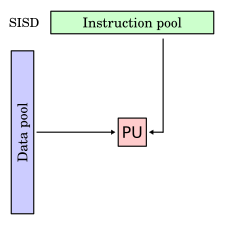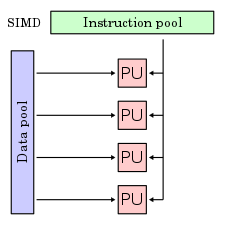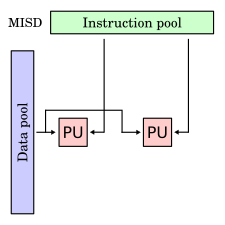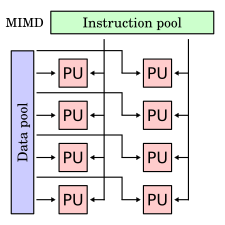Parallel Processing | SISD,SIMD,MIMD,MISD
SISD (Single Instruction, Single Data stream)
Single Instruction, Single Data (SISD) refers to an Instruction Set Architecture in which a single processor (one CPU) executes exactly one instruction stream at a time and also fetches or stores one item of data at a time to operate on data stored in a single memory unit. Most of the CPU design, based on the von Neumann architecture, from the beginning till recent times are based on the SISD. The SISD model is a typical non-pipelined architecture with the general-purpose registers, as well as dedicated special registers such as the Program Counter (PC), the Instruction Register (IR), Memory Address Registers (MAR) and Memory Data Registers (MDR).

SIMD (Single Instruction, Multiple Data streams)
Single Instruction, Multiple Data (SIMD) is an Instruction Set Architecture that have a single control unit (CU) and more than one processing unit (PU) that operates like a von Neumann machine by executing a single instruction stream over PUs, handled through the CU. The CU generates the control signals for all of the PUs and by which executes the same operation on different data streams. The SIMD architecture, in effect, is capable of achieving data level parallelism just like with vector processor.
Some of the examples of the SIMD based systems include IBM's AltiVec and SPE for PowerPC, HP's PA-RISC Multimedia Acceleration eXtensions (MAX), Intel's MMX and iwMMXt, SSE, SSE2, SSE3 and SSSE3, AMD's 3DNow! etc.

MISD (Multiple Instruction, Single Data stream)
Multiple Instruction, Single Data (MISD) is an Instruction Set Architecture for parallel computing where many functional units perform different operations by executing different intructions on the same data set. This type of architecture is common mainly in the fault-tolerant computers executing the same instructions redundantly in order to detect and mask errors.

MIMD(Multiple Instruction, Multiple Data streams)
Multiple Instruction stream, Multiple Data stream (MIMD) is an Instruction Set Architecture for parallel computing that is typical of the computers with multiprocessors. Using the MIMD, each processor in a multiprocessor system can execute asynchronously different set of the instructions independently on the different set of data units. The MIMD based computer systems can used the shared memory in a memory pool or work using distrbuted memory across hetrogeneous network computers in a distributed environment. The MIMD architectures is primarily used in a number of application areas such as computer-aided design/computer-aided manufacturing, simulation, modeling, communication switches etc.




No comments :
Post a Comment